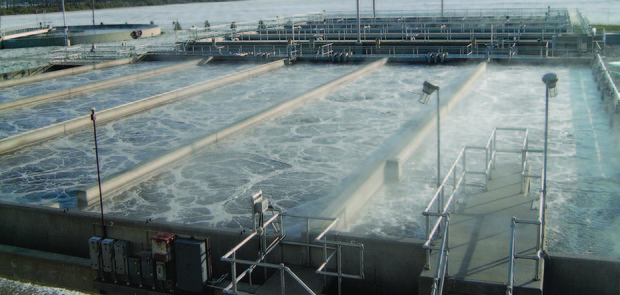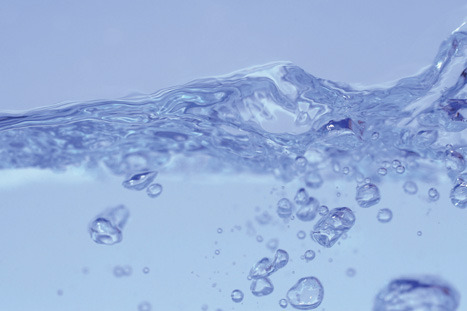Bubbling up energy savings
9 Oct 2012
Paul Barter, principal process engineer for Hydro International’s wastewater division looks at energy-intensive the aeration process and examines ultra-fine bubble aeration, a technology new to the UK that promises up to 30% efficiency gains at wastewater treatment facilities:
The quest for energy savings, improved carbon footprint and lower whole-life costs is becoming a significant driver for innovation in wastewater treatment plants.
About half the UK’s wastewater operators use an activated sludge process for secondary treatment and the energy demands on mixing and aerating are by far the biggest drain on energy budgets.
Aeration can consume between 54 and 97% of total energy, depending on the configuration of the plant, according to a recent study.
Energy costs account for 15-30% of large, and 30-40% of small WWTP’s operating and maintenance budgets2. So increasing the efficiency of the activated sludge system will significantly reduce operating costs.
Good aeration is all about maximising the contact of oxygen from air with the wastewater. There are various processes used for aeration, the most common being the Fine Bubble Diffused Air (FBDA) process; other systems such as surface aeration or jet aeration are still used, but are less popular.
The FBDA process is based on perforated rubber disk membranes placed at the bottom of the ditch, through which air is blown to create the bubbles that rise and aerate the mixture.
The most efficient process up until now, the FBDA process still only achieves a moderate Standard Oxygen Transfer Efficiency (SOTE) and some of the opportunity to transfer oxygen is missed. Nevertheless, FBDA systems remain a major energy drain on O&M budgets.
One new technology - Ultra-Fine Bubble Aeration (UFBA) - claims to achieve up to 30% higher SOTE than conventional fine bubble diffusers. UFBA uses rectangular diffusers to deliver many more smaller bubbles over a much larger floor area.
Let’s look at the aeration process itself and examine the opportunities for improving efficiency. What are the options available to improve SOTE?
Increased contact area
Increasing the contact area of the air to the wastewater provides a greater opportunity for oxygen transfer. For a submerged system, this usually relates to having a smaller bubble.
The smaller the bubble, the larger the ratio between the bubble’s surface area and its volume. In UFBA, the 1mm bubble has three times the surface area of a 3mm bubble typical of FBDA systems, leading to a significant improvement in the opportunities for oxygen transfer.
Increasing the time that the bubble is in contact with the wastewater will also improve the transfer process. Of course, the easiest solution would simply be to have a deeper tank, but in most cases it’s not a practical solution.
A simple bit of classroom science can point us to a clever alternative: buoyancy is a function of the difference between the volume and density of the fluid displaced. Therefore small bubbles have much lower buoyancy and will rise through the wastewater more slowly.
Bouyancy
So, a 1mm bubble has four times less buoyancy force than a 2mm bubble and nine times less than a 3mm bubble. The bubble has a slower ascent through the wastewater, and therefore increased contact time for oxygen transfer.
It’s also important to decrease the resistance to transfer.
There are many constituents of wastewater that restrict the transfer of oxygen from the air to the wastewater, loosely collected together and applied as the alpha and beta factors for oxygen transfer, converting the Actual Oxygen Requirement (AOR) into a Standard Oxygen Requirement (SOR).
If these constituents can be mitigated, then the alpha and beta factors could rise, meaning less resistance to oxygen transfer. In this respect, both FBDA systems and UFBA systems perform the same.
Increasing the partial pressure of oxygen in the air bubbles would also achieve higher transfer of oxygen to the wastewater, as with enriched oxygen and pure oxygen activated sludge systems.
This is indeed an opportunity to increase SOTE, but enriching oxygen is an expense both in capital equipment and operation, so any efficiency gains would need to be balanced against the additional costs.
Operators of activated sludge plants will already understand the importance of minimising the amount of dissolved oxygen in the wastewater and therefore maximising the difference in the transfer.
They achieve the lowest possible measures through good plant control, but problems can occur where plant is not calibrated correctly, or where operators do not want to risk pushing the dissolved oxygen levels too close to zero and closing down the process altogether.
Reducing the amount of dissolved oxygen through good plant maintenance and control should be an objective for any activated sludge process.
But even in well-run plants, there can still be localised areas where the dissolved oxygen levels are too high. Disk diffusers systems have only 10% floor coverage, and therefore all the air available for oxygen transfer travels through 10% of the volume of the tank. The more air per area, the more likely that any individual bubble will adversely affect the transfer properties of an adjacent bubble.
Flux
Because they have a far greater floor area, ultra-fine bubble diffusers lower the flux rate, where flux is the volume of air per membrane surface area. The higher the flux, the more air is being applied to each square metre of membrane areas. The lower the flux rate, the higher the efficiency.
In conclusion, aeration is the most energy-hungry operation in sewage treatment and can consume up to 40% of WWTP’s operating budgets.
It’s no surprise, then, that achieving energy efficiencies in aeration is becoming something of a ‘holy grail’ for asset managers, as even small efficiency ‘wins’ can make a big difference to the bottom line.
Plant innovation with technologies, such as UFBA, has the potential to deliver a step change in aeration efficiency.





